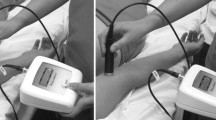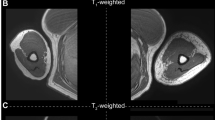Abstract
Background
No consensus exists with respect to a commonly accepted and standardized method for measuring arm volumes in patients with lymphedema. Knowing the exact volume in (potential) lymphedemic arms and comparing this volume with healthy arms is important to detect the first signs of lymphedema and to study the effects of treatment.
Methods
A new apparatus, based upon the principle of measuring shortness of water, was developed to measure arm volumes. This measuring-method, inverse water volumetry, was prospectively validated in patients, suffering from lymphedema after complete or partial mastectomy for primary breast cancer. Healthy and lymphedemic arm were measured 3 times: twice by nurse A (A1 and A2) and once by nurse B (B). Subsequently, these differences in volumes were compared with differences in volumes obtained by the Herpertz method, which is based upon circumferential measurement.
Results
In every patient at every occasion volume of the lymphedemic arm was bigger than the corresponding volume of the control arm. Mean volumes of healthy arms were 3958(A1), 3966(A2) and 3961(B) ml respectively. Mean volumes of lymphedemic arms were 4721(A1), 4752(A2) and 4773(B) ml respectively, volume B being significantly different from volume A1. Volume difference of edemic arms minus control arms was not significant between measurements (A1 vs. A2 and A1 vs. B, respectively), while this difference was significant (A1 vs. B) using the Herpertz method.
Conclusion
Inverse water volumetry is an easy measuring device with a high inter- and intra-observer agreement. The small but significant volume increase of lymphedemic arms in time compared to the constant volumes of control arms is as well indicative for the accuracy of the method as for the volume of lymphedemic arms to increase when no therapeutic garment is carried.
Similar content being viewed by others
Literature
Kissin MW, Querci della Rovere G, Easton D, Westbury G (1986) Risk of lymphedema following treatment of breastcancer. Br J Surg 73:580–584
Schunemann H, Willich N (1997) Lymphedema after breastcancer. A study of 5868 casus. Dtsch Med Wochenschr 122(17):536–541
Kiel KD, Rademacker AW (1996) Early stage breastcancer: edema after wide excicion and breast radiation. Radiology 198:279–283
Liljegren G, Holmberg L (1997) Arm mobility after sector resection and axillary dissection with and without postoperative radiotherapy in breastcancer stage I. Results from a randomised trial. Uppsala Orebro Breast Cancer Study Group. Eur J Cancer 33:193–199
Cornish HB, Bunce IH, Ward LC, et al (1996) Bio-electrical impedance for monitoring the efficacy of lymphedema treatment programmes. Breast Cancer Res Treat 38:169–176
Schunemann H, Willich N (1998) Lymphedema of the arm after primary treatment of breast cancer. Anticancer Res 18:2235–2236
Ramos SM, Oȁ9Donell LS, Knight G (1999) Edema volume, not timing, is the ley to success in lymphedema treatment. Am J Surg 178:311–315
Mortimer PS, Bates DO, Brassington HD, Stanton AWB, et al (1996) The prevalence of arm oedema following treatment for breast cancer. Q J Med 89:377–380
Pezner RD, Patterson MP, Hill LR (1986) Arm edema in patients treated conservatively for breast cancer: relationship to patient age and axillary node dissection technique. Int Radiat Oncol Biol Phys 12:2079–2083
Dewar JA, Sarrazin D, Benhamou et al (1987) Management of the axilla in concervatively treated breast cancer. 592 patients treated at Institut Gustave-Roussy. Int J Radiat Oncol Biol Phys 13:475–480
Larson D, Weinstein M, Goldberg I, et al (1986) Edema of the arm as a function of the extent of axillary surgery in patients with stage I–II carcinoma of the breast treated with primary radiotherapy. Int J Radiat Oncol Biol Phys 12:1575–1582
Sitzia J (1995) Volume measurement in lymphedema treatment: examination of formulae. Eur J Cancer Care 4:11–16
Kuhnke E (1976) Volumbestimmung aus Umfangmessungen. Folia Angiologica 24:228–232
Lennihan R, Mackereth M (1973) Calculating volume changes in a swollen extremity from surface measurements. Am J Surg 126:649–652
Brown J (2004) A clinically useful method for evaluating lymphedema. Clin J Oncol Nurs 8(1):35–38
Göltner E, Fishbach JU, Mönter B, Kraus A, Vorherr H (1985) Objektivierung des Lymphödems nach Mastektomie. Deutsche Med Wochenschrift 110:949–952
Cornish BH, Bunce IH, Ward LC, Jones LC, Thomas BJ (1996) Bioelectrical impedance for monitoring the efficacy of lymphedema treatment programmes. Breast Cancer Res Treat 38:169–176
Brismar B, Ljungdahl I (1982) Postoperative lymfoedema after treatment of breast cancer. Acta Chir Scand 149:687–689
Farncombe M, Daniels G, Cross L (1994) Lymphedema: the seemingly forgotten complication. J Pain Sympt Manage 9:269–276
Ryttov N, Holm V, Qvist N, Blichert-Toft M (1988) Influence of adjuvant irradiation on the development of late arm mastectomy for carcinoma of the breast. Acta Oncologica 27:667–670
Lin PP, Allison DC, Wainstock J, et al (1993) Impact of axillary lymph node dissection on the therapy of breastcancer patients. J Clin Oncol 11:1136–1144
Herpertz U (1994) Messung und Dokumentation von Ödemen. Lymphologie 18:24–30
Meijer RS, Rietman JS, Geertzen JH, Bosmans JC, Dijkstra PU (2004) Validity and intra- and interobserver reliability of an indirect volume measurements in patients with upper extremity lymphedema. Lymphology 37(3):127–133
Kaulesar DMKS, den Hoed PT, Johannes EJ, van Dolder R, Benda E (1993) Direct and indirect methods for quantification of leg volume: comparison between water displacement volume try, the disk model and the frustum sign model, using correlation coefficient and the limits of agreement. J Biomed Eng 15:477–480
Stranden E (1981) A comparison between surface measurements and water displacement volumetry for the quantification of leg edema. J Oslo City Hosp. 31:153–5
Mortimer PS (1990) Investigation and management of lymphedema. Vasc Med Rev. 1:1–20
Segerstrom K, Bjerle P, Graffman S, Nystrom A (1992) Factors that influence incidence of brachial edema after treatment of breast cancer. Scand J Plast Reconstr Hand Surg 26:223–237
Kettle JH, Ruindle FF, Oddie TH (1958) Measurement of upper limb volumes: a clinical method. Aust NZ J Surg 27:263–270
Veraart JCJM, Movig I, Asselman AH, Neumann HAM (1995) The volometer and the perometer; a clinical comparison. Scripta Phlebologica 5:9–11
Armer JM, Stwewart BR (2006) A comparison of four diagnostic criteria for lymphedema in a Post-Breast cancer polulation. Lymph Res Biol 3(4):208–217
Megens AM, Harris SR, Kim-Sang C, McKinzie DC (2001) Measurement of upper extremity volume in women after axillary dissection for breast cancer. Arch Phys Med Rehabil 82(12):1639–1644
Maunsell E, Brisson J, Deschenes L (1993) Arm problems and psychological distress after surgery of breast cancer. Can J Surg 36:315–320
Velanovich V, Szymanski W (1999) Quality of life of breast cancer patients with lymphedema. Am J Surg 177:184–188
Ganz PA (1999) The quality of life after breast cancer-solving the problem of lymphedema. New Eng J Med 5(340):383–387
Pain SJ (2000) Purushotham. Lymphedema following surgery for breast cancer. Br J Surg 87:1128–1141
Author information
Authors and Affiliations
Corresponding author
Rights and permissions
About this article
Cite this article
Damstra, R.J., Glazenburg, E.J. & Hop, W.C.J. Validation of the inverse water volumetry method: a new gold standard for arm volume measurements. Breast Cancer Res Treat 99, 267–273 (2006). https://doi.org/10.1007/s10549-006-9213-0
Received:
Accepted:
Published:
Issue Date:
DOI: https://doi.org/10.1007/s10549-006-9213-0




